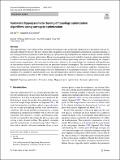Automatic hyperparameter tuning of topology optimization algorithms using surrogate optimization
Author(s)
Ha, Dat; Carstensen, Josephine
Download158_2024_Article_3850.pdf (2.278Mb)
Publisher with Creative Commons License
Publisher with Creative Commons License
Creative Commons Attribution
Terms of use
Metadata
Show full item recordAbstract
This paper presents a new approach that automates the tuning process in topology optimization of parameters that are traditionally defined by the user. The new method draws inspiration from hyperparameter optimization in machine learning. A new design problem is formulated where the topology optimization hyperparameters are defined as design variables and the problem is solved by surrogate optimization. The new design problem is nested, such that a topology optimization problem is solved as an inner problem. To encourage the identification of high-performing solutions while limiting the computational resource requirements, the outer objective function is defined as the original objective combined with penalization for intermediate densities and deviations from the prescribed material consumption. The contribution is demonstrated on density-based topology optimization with various hyperparameters and objectives, including compliance minimization, compliant mechanism design, and buckling load factor maximization. Consistent performance is observed across all tested examples. For a simple two hyperparameter case, the new framework is shown to reduce amount of times a topology optimization algorithm is executed by 90% without notably sacrificing the objective compared to a rigorous manual grid search.
Date issued
2024-09-04Department
Massachusetts Institute of Technology. Department of Civil and Environmental EngineeringJournal
Structural and Multidisciplinary Optimization
Publisher
Springer Berlin Heidelberg
Citation
Ha, D., Carstensen, J. Automatic hyperparameter tuning of topology optimization algorithms using surrogate optimization. Struct Multidisc Optim 67, 157 (2024).
Version: Final published version